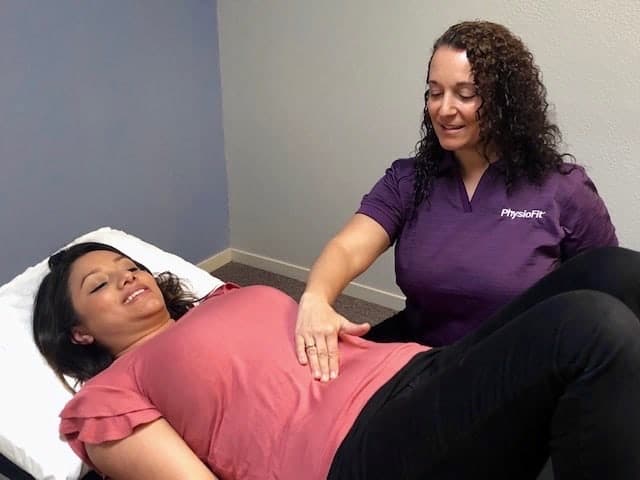Understanding Diastasis Recti
- Are you worried about your "mummy tummy" or "mommy pooch" and feel embarrassed to discuss it with anyone?
- Are you embarrassed that you still look pregnant months after giving birth?
- Are you frustrated and lacking the body confidence you once had?
- Does it concern you that you’re unable to get back in shape, lose weight and feel strong again?
- Are you missing out on your favorite activities because you might leak when you jump, sneeze or laugh?
- Do you find sex painful or uncomfortable?
If any of these describe you, we want you to know that you are not alone...
And we hear our clients talk about these feelings all the time! In fact, Diastasis Recti is a very common problem that we see in our women’s health clinic in Los Altos.
We see people like this all the time and it's one of our key specialties!
I assure you, you’ve come to the right place.
Signs & Symptoms
Your core muscles, including your pelvic floor, do not operate independently of each other. They are interconnected both anatomically and neurologically. So, when one group of core muscles experiences dysfunction, your entire core unit can exhibit abnormal signs and symptoms.
This is why women experiencing diastasis recti during and after pregnancy may notice a range of issues, including:
- Doming or bulging on the front of the abdomen.
- A palpable or visible gap in the middle of the stomach, often more prominent when bending forward.
- Pelvic floor dysfunction, including constipation or urinary incontinence.
- Low back pain or pelvic pain.
- A sense of weakness or flabbiness in the torso.
Why PhysioFit Physical Therapy?
You will have a private 1-1 evaluation with a physical therapist. The evaluation includes your medical history, a movement analysis, and an assessment of your posture, muscles, and nerves.
EMOTIONS YOU MAY BE FEELING
- Loss of self-confidence in your new appearance
- Weaker when exercising
- Easily fatigued


Typical limitations
- It's important to avoid certain activities that may make diastasis recti worse.
- These include crunches, ab twists, planks, backward bends that stretch the abdominal area, certain yoga poses, or any type of heavy lifting activities that bulge out the stomach.
Get your desired outcome
- Feel better in fitted clothes
- Get back in shape with safe exercise guidance without pain

Let's Get Started!
"If you feel disappointed, let down, or Just confused by the advice you’ve been given… you’re not alone, and I’d like to offer you my hel for FREE!"
Free Guide For Anyone Who Wants To End
Diastasis Recti:
6 Tips To Avoid Surgery For Diastasis Recti And Regain Control Of Your Body

How Can Choosing To See A Physical Therapy Specialist At PhysioFit Help You To Heal Your Diastasis Recti?
Here are just a few of the things our Physical Therapy Team can do for you:
- We will thoroughly evaluate your spine, pelvis, and abdominals and determine the most appropriate plan of action.
- We can quickly take away any other pain and stiffness, usually within a couple of sessions.
- We will ensure that your problem is addressed and “corrected” so you can heal properly. Then, we will provide you with the perfect set of exercises that will speed up your recovery.
- We can help you avoid dangerous abdominal surgery.
- We can help you to finally feel more confident about your body and eliminate any worry that the issue might get worse or hinder you from the workouts you WANT to do! Our 20-Minute Phone Consultation comes at NO risk to you. We will have an honest conversation about your health to decide if we will be a good fit to work with each other.
Patient Stories
"I had an amazing experience at PhysioFit working with my therapist. Since my 2nd pregnancy three years ago, I haven't been able to recover from diastasis recti and have felt really insecure about my stomach area and weak in the core for years. In my first visit, I was diagnosed and measured my diastasis, and explained why the stomach exercises that I was doing weren't working. She then gave me a set of exercises to start with at home and over the next few weeks, ramped up to more challenging exercises as I started to get stronger in my core. Throughout the time that we worked together, she was extremely encouraging and patient while also correcting my form to make sure I was doing the exercises correctly. Not only am I on a path towards recovery, I also feel hopeful again! Thank you PhysioFit!"
- Verna, Mountain View
"I didn't know there were services that addressed post partum issues women deal with like pelvic floor therapy and blocked ducts treatments."
Carol W. | Los Altos, CA
"About 2 months after I delivered my baby, I developed plugged ducts from breastfeeding. As a new mom, I had spoken with several moms who had varying levels of challenges trying resolving them. After scouring the internet, and trying everything to resolve the plugs, my midwife/physician referred me to PhysioFit for plugged-duct physical therapy. I had never considered physical therapy as being a possible solution, but through their combination of massage and ultrasound treatment, we were able to get the ducts unplugged without needing surgery. One of the things that was really encouraging about this form of therapy was that it's completely non-invasive, and the technicians made me feel very comfortable in the sessions. There was no down-time, or healing time so I could still go about my life, nursing my baby, going to work, etc. PhysioFit is one of the first (and few) studios to offer this type of treatment, and I love that they have been innovators in offering effective alternative treatments to plugged ducts compared to surgery."
Diastasis Recti Frequently Asked Questions:
Most people think that when they get Diastasis Recti (abdominal separation) it’s simply going to improve by doing enough crunches.
Several months later you're still living with abdominal separation or Diastasis Recti (and have been told surgery may be your only option) and some other new issues may start happening like back pain or “leaking” when you cough or sneeze”.
Well, here are 3 things you can do:
- First things first, you need to make a decision about getting proper help. So many people procrastinate for so long, thinking that Diastasis Recti will "just go away with time," but then 6 months down the line they’re still putting up with it. Worst off...nothing has really changed… or it gets worse.
- Next, you need to do the RIGHT exercises. One of the best things that we do to help you ease your abdominals is to do the right SERIES of progressed exercises. The right exercises given to you by a Physical Therapist will help ease any pain, improve your core strength from the “inside out” and allow you to feel more confident about your body. How does that sound?
- You need to get some real, “hands-on” Physical Therapy treatment. Physical Therapy is proven to help people with diastasis recti if done the right way! In fact, at PhysioFit it’s one of the most common women’s health issues we see. Often times it is accompanied by back pain, pelvic floor weakness, or hip issues. Women's Health Physical Therapy can help get you back to living the life you deserve and make your feel more empowered to take on fitness activities the RIGHT way!
Another scenario that we see quite frequently in our physical therapy clinic is when people are told “you need surgery and that is the only way to resolve it". Does that sound familiar?
But wait... it gets even better! This approach is extreme and risky as many women don’t want to go under the knife, or don’t have the time to be down resting when they have a family to care for...not to mention the huge expense. Also, this surgery can come with complications and is important to work on strength in the abdominal muscles underneath first. Isn’t it better to treat it conservatively instead?
Other times many women go online to find solutions, they do a Google or YouTube search for answers to the problem, they’ve tried it all but still no significant change!

 Los Altos, CA
Los Altos, CA


